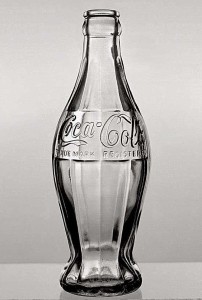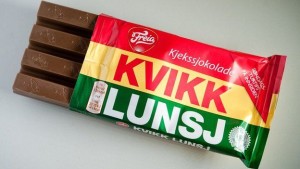
Take a look at the picture above. Do you know what it is? Can you identify it? Of course you can! You probably remember its catchy ”Gimme a break” jingle. You might even be snacking on one right now. The four-columned, snaptastic confection is so universally recognizable that its very shape is a trademark. Or so one would think.
Can shapes be trademarked? The answer is yes, but unfortunately not the beloved KitKat bar. Here’s why…
In order for a 3D shape to be a trademark it’s got to be so distinctive that when people see it  they know exactly what product it represents, and who makes that product. For example, you see one of these artifacts to the right and you recognize it as the container of the most ubiquitous high-calorie soft drink on Earth. You may not know that Coca-cola was invented by a Confederate Colonel to cure his morphine addiction, or how much blow was in the original recipe, or that it was first sold as a medicinal cure for dyspepsia, headache and impotence. You may not know that some people in Atlanta put Coke on their breakfast cereal instead of milk (truth—seen it personally). You may not even know that the curvy glass vessel is called the ”hobbleskirt bottle,” but that’s all beside the point. In a survey conducted in the early 1960’s, 98% of the public recognized the bottle as a symbol for Coke—whether or not it contained anything—and that was good enough for a trademark.
they know exactly what product it represents, and who makes that product. For example, you see one of these artifacts to the right and you recognize it as the container of the most ubiquitous high-calorie soft drink on Earth. You may not know that Coca-cola was invented by a Confederate Colonel to cure his morphine addiction, or how much blow was in the original recipe, or that it was first sold as a medicinal cure for dyspepsia, headache and impotence. You may not know that some people in Atlanta put Coke on their breakfast cereal instead of milk (truth—seen it personally). You may not even know that the curvy glass vessel is called the ”hobbleskirt bottle,” but that’s all beside the point. In a survey conducted in the early 1960’s, 98% of the public recognized the bottle as a symbol for Coke—whether or not it contained anything—and that was good enough for a trademark.
Intellectual property protections are, in fact, available to variously-shaped foodstuffs. For example, the “hyperbolic paraboloid” design of Pringles stackable potato snacks is patented. They’re called potato ”snacks” instead of ”chips,” btw, because they consist of only 42% potatoes; the remainder of the ingredients are unpronounceable chemical compounds required to maintain their saddle shape so they can be stuffed into cans. Frito-Lay obtained two different patents for its Tostitos Scoops Chips—you know, the ones shaped like little bowls so you can load in some salsa and not worry about it dumping down the front of your guayabera. Those patents are titled ”Process for Making a Shaped Snack Chip” and ”System and Method for Molding a Snack Chip,” but we don’t need to talk about them because patent law is for scientific geeks.
Instead, let’s get back to chocolate. (Let’s always get back to chocolate.) Toblerone’s 3D ”zigzag prism” shape is a trademark, although that’s a silly name for a trademark descriptor. Hershey’s Kisses are not trademarked, although the company does have trademarks for its foil wrappers and the printed paper ”plume” emerging pennant-like from the darling little candies.
So why no TM for our four-fingered friend? Well, for starters, the treat pictured up top is NOT a KitKat. It’s a Kvikk Lunsj bar, a similar product made in Norway since 1937 that translates loosely to ”Quick Lunch.” Here’s how it looks with its clothes on:
It wasn’t Kvikk Lunsj’s manufacturer, Freia, that blocked KitKat’s trademark registration as a shape. Norwegians don’t care about anything except hockey and death metal. No, the culprit was Cadbury, the eminent British chocolatier and NestlÁ©’s arch nemesis.
Cadbury disputed NestlÁ©’s claim to a trademark of the 3D shape of the KitKat, which it had obtained from the United Kingdom Intellectual Property Office (UKIPO) in 2006. The move was retaliatory: In 2010, NestlÁ© opposed Cadbury’s attempt to trademark the color purple for the foil wrappers on its sweets. (Unclear if Alice Walker weighed in.) So, Cadbury opposed NestlÁ©’s KitKat trademark even though it has no competing product. Nonetheless, in 2013, Cadbury’s cancellation bid was upheld on grounds that there was no inherent distinctiveness to the 3D shape, because each of the KitKat’s ”fingers” are just basic trapezoids that do not result in a distinctive shape when aligned in a row. Even though 90% of respondents in a street survey recognized that familiar shape as a KitKat, UKIPO still decided that the confection did not have ”inherently distinctive character.”
It’s hard to take anything UKIPO says seriously because it sounds like a cuddly Pokemon character. Or a chocolate bar. But this month, the more gravely titled Court of Justice of the European Union agreed with the British office’s decision, determining that public recognition of the shape and association with the mark is insufficient to warrant trademark protection of the popular treat’s form. (NestlÁ© has trademarks for the name and logo of the KitKat in the U.S., but hasn’t attempted to trademark its 3D shape here.)
Is there a moral to the story? Not necessarily. The gripe in the KitKat case was not so much an analysis of product distinctiveness as a spitefest between rival corporate giants. I guess one can say that if you seek trademark protection for a four-fingered shape it better be really distinctive, or you’re liable to get the one-finger salute.










Comments